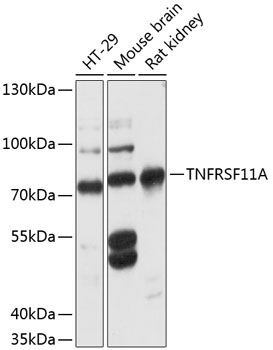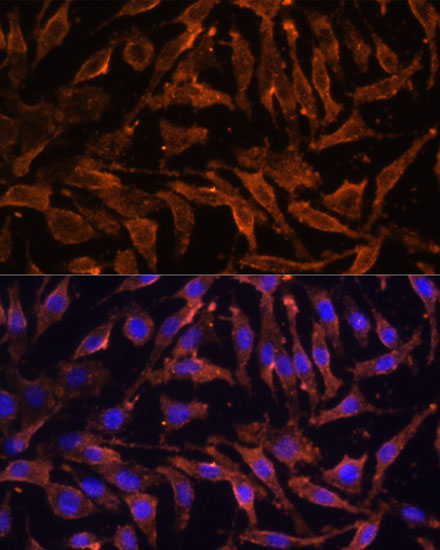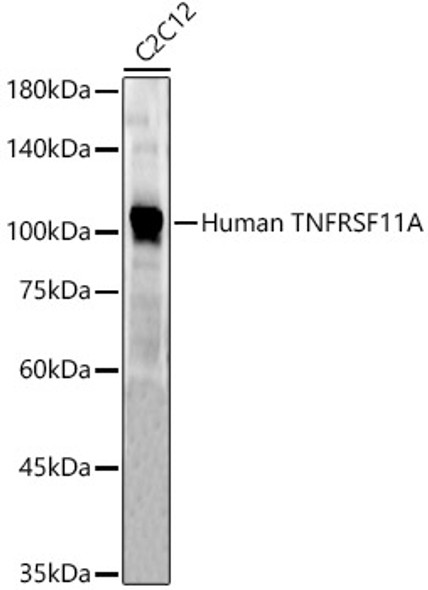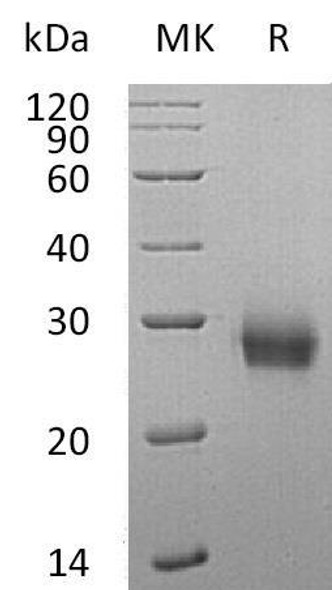Immunology Antibodies 1
Anti-TNFRSF11A Antibody (CAB12997)
- SKU:
- CAB12997
- Product Type:
- Antibody
- Reactivity:
- Human
- Reactivity:
- Mouse
- Reactivity:
- Rat
- Host Species:
- Rabbit
- Isotype:
- IgG
- Antibody Type:
- Polyclonal Antibody
- Research Area:
- Immunology
Description
| Antibody Name: | Anti-TNFRSF11A Antibody |
| Antibody SKU: | CAB12997 |
| Antibody Size: | 20uL, 50uL, 100uL |
| Application: | WB IHC IF |
| Reactivity: | Human, Mouse, Rat |
| Host Species: | Rabbit |
| Immunogen: | Recombinant fusion protein containing a sequence corresponding to amino acids 466-616 of human TNFRSF11A (NP_003830.1). |
| Application: | WB IHC IF |
| Recommended Dilution: | WB 1:1000 - 1:2000 IHC 1:100 - 1:100 IF 1:50 - 1:100 |
| Reactivity: | Human, Mouse, Rat |
| Positive Samples: | HT-29, Mouse brain, Rat kidney |
| Immunogen: | Recombinant fusion protein containing a sequence corresponding to amino acids 466-616 of human TNFRSF11A (NP_003830.1). |
| Purification Method: | Affinity purification |
| Storage Buffer: | Store at -20'C. Avoid freeze / thaw cycles. Buffer: PBS with 0.02% sodium azide, 50% glycerol, pH7.3. |
| Isotype: | IgG |
| Sequence: | RGPL PQCA YGMG LPPE EEAS RTEA RDQP EDGA DGRL PSSA RAGA GSGS SPGG QSPA SGNV TGNS NSTF ISSG QVMN FKGD IIVV YVSQ TSQE GAAA AAEP MGRP VQEE TLAR RDSF AGNG PRFP DPCG GPEG LREP EKAS RPVQ EQGG AKA |
| Gene ID: | 8792 |
| Uniprot: | Q9Y6Q6 |
| Cellular Location: | Cell membrane, Single-pass type I membrane protein |
| Calculated MW: | 28kDa/32kDa/36kDa/56kDa/64kDa/66kDa |
| Observed MW: | 75kDa |
| Synonyms: | TNFRSF11A, CD265, FEO, LOH18CR1, ODFR, OFE, OPTB7, OSTS, PDB2, RANK, TRANCER |
| Background: | The protein encoded by this gene is a member of the TNF-receptor superfamily. This receptors can interact with various TRAF family proteins, through which this receptor induces the activation of NF-kappa B and MAPK8/JNK. This receptor and its ligand are important regulators of the interaction between T cells and dendritic cells. This receptor is also an essential mediator for osteoclast and lymph node development. Mutations at this locus have been associated with familial expansile osteolysis, autosomal recessive osteopetrosis, and Paget disease of bone. Alternatively spliced transcript variants have been described for this locus. |
| UniProt Protein Function: | TNFRSF11A: Receptor for TNFSF11/RANKL/TRANCE/OPGL; essential for RANKL-mediated osteoclastogenesis. Involved in the regulation of interactions between T-cells and dendritic cells. Binds to the clefts between the subunits of the TNFSF11 ligand trimer to form a heterohexamer. Interacts with TRAF1, TRAF2, TRAF3, TRAF5 and TRAF6. Interacts (via cytoplasmic domain) with GAB2. Ubiquitous expression with high levels in skeletal muscle, thymus, liver, colon, small intestine and adrenal gland. |
| UniProt Protein Details: | Protein type:Membrane protein, integral Chromosomal Location of Human Ortholog: 18q21.33 Cellular Component: external side of plasma membrane; integral to plasma membrane; plasma membrane Molecular Function:cytokine binding; protein binding; receptor activity; transmembrane receptor activity; tumor necrosis factor receptor activity Biological Process: activation of NF-kappaB transcription factor; adaptive immune response; cell-cell signaling; circadian thermoregulation; inflammatory response; osteoclast differentiation; positive regulation of cell proliferation; positive regulation of JNK activity; positive regulation of transcription factor activity; regulation of apoptosis; response to cytokine stimulus; response to lipopolysaccharide; signal transduction; tumor necrosis factor-mediated signaling pathway Disease: Familial Expansile Osteolysis; Osteopetrosis, Autosomal Recessive 7; Paget Disease Of Bone |
| NCBI Summary: | The protein encoded by this gene is a member of the TNF-receptor superfamily. This receptors can interact with various TRAF family proteins, through which this receptor induces the activation of NF-kappa B and MAPK8/JNK. This receptor and its ligand are important regulators of the interaction between T cells and dendritic cells. This receptor is also an essential mediator for osteoclast and lymph node development. Mutations at this locus have been associated with familial expansile osteolysis, autosomal recessive osteopetrosis, and Paget disease of bone. Alternatively spliced transcript variants have been described for this locus. [provided by RefSeq, Aug 2012] |
| UniProt Code: | Q9Y6Q6 |
| NCBI GenInfo Identifier: | 19924309 |
| NCBI Gene ID: | 8792 |
| NCBI Accession: | Q9Y6Q6.1 |
| UniProt Secondary Accession: | Q9Y6Q6,Q59EP9, I4EC36, I4EC38, I4EC39, I7JE63, N0GVH0 |
| UniProt Related Accession: | Q9Y6Q6 |
| Molecular Weight: | |
| NCBI Full Name: | Tumor necrosis factor receptor superfamily member 11A |
| NCBI Synonym Full Names: | TNF receptor superfamily member 11a |
| NCBI Official Symbol: | TNFRSF11A |
| NCBI Official Synonym Symbols: | FEO; OFE; ODFR; OSTS; PDB2; RANK; CD265; OPTB7; TRANCER; LOH18CR1 |
| NCBI Protein Information: | tumor necrosis factor receptor superfamily member 11A |
| UniProt Protein Name: | Tumor necrosis factor receptor superfamily member 11A |
| UniProt Synonym Protein Names: | Osteoclast differentiation factor receptor; ODFR; Receptor activator of NF-KB; CD_antigen: CD265 |
| UniProt Gene Name: | TNFRSF11A |








